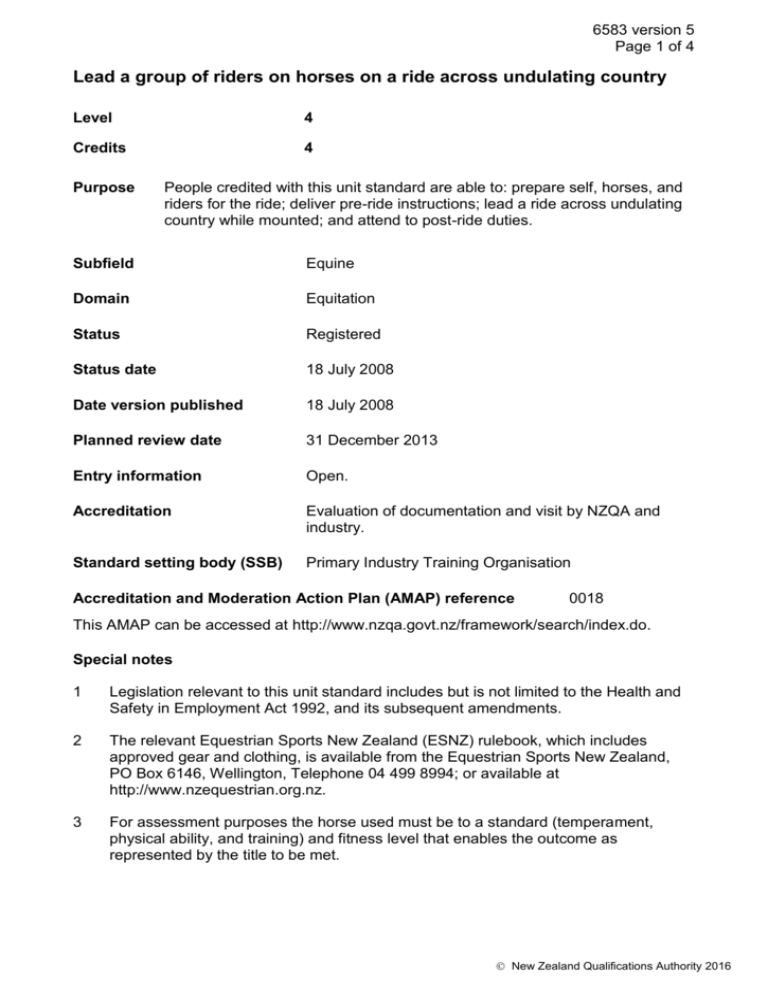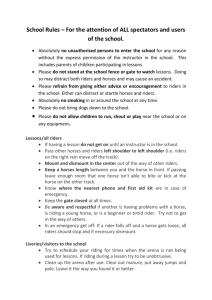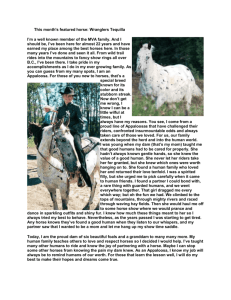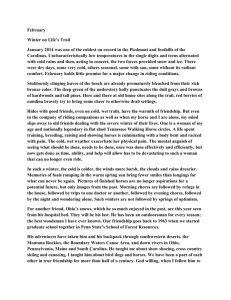6583 Lead a group of riders on horses on a ride across
advertisement

6583 version 5 Page 1 of 4 Lead a group of riders on horses on a ride across undulating country Level 4 Credits 4 Purpose People credited with this unit standard are able to: prepare self, horses, and riders for the ride; deliver pre-ride instructions; lead a ride across undulating country while mounted; and attend to post-ride duties. Subfield Equine Domain Equitation Status Registered Status date 18 July 2008 Date version published 18 July 2008 Planned review date 31 December 2013 Entry information Open. Accreditation Evaluation of documentation and visit by NZQA and industry. Standard setting body (SSB) Primary Industry Training Organisation Accreditation and Moderation Action Plan (AMAP) reference 0018 This AMAP can be accessed at http://www.nzqa.govt.nz/framework/search/index.do. Special notes 1 Legislation relevant to this unit standard includes but is not limited to the Health and Safety in Employment Act 1992, and its subsequent amendments. 2 The relevant Equestrian Sports New Zealand (ESNZ) rulebook, which includes approved gear and clothing, is available from the Equestrian Sports New Zealand, PO Box 6146, Wellington, Telephone 04 499 8994; or available at http://www.nzequestrian.org.nz. 3 For assessment purposes the horse used must be to a standard (temperament, physical ability, and training) and fitness level that enables the outcome as represented by the title to be met. New Zealand Qualifications Authority 2016 6583 version 5 Page 2 of 4 4 Stable procedures are the documented practices and polices required within a particular workplace, and do not contravene the Code of Recommendations and Minimum Standards for Welfare of Horses (Wellington: Ministry of Agriculture and Forestry, 1993), available at http://www.biosecurity.govt.nz/animalwelfare/codes/horses/index.htm. Elements and performance criteria Element 1 Prepare self, horses, and riders for the ride. Performance criteria 1.1 Rider is attired in ESNZ approved gear and clothing which is appropriate and safe for general riding. 1.2 Horses are geared up in saddlery suited to and comfortable for the individual horse, and which enables control by the rider and affords protection to limbs of the horse. Range bridle and bit, saddle and stirrup leather length, martingale, breastplate, leg protection for horse. 1.3 Horse are of a standard and fitness level to comfortably complete the ride without endangering the rider or other horses and riders. 1.4 Saddlery and equipment used for horses and riders are safe to use, and clean and tidy, and suitable for the intended purpose. Element 2 Deliver pre-ride instructions. Performance criteria 2.1 Riders are instructed on riding position and methods of control in accordance with the individual horse, in a manner which is easily understood. 2.2 Details of ride are explained in a manner which enables the riders to gain information on what to expect and what is expected of them on the ride. Range 2.3 duration of ride, type of country to be covered, hazards to note, horse behaviour details, riding etiquette. Group safety procedures and etiquette are explained in relation to passing other horses, riding on private land, opening and closing gates, and waiting for slower horses. New Zealand Qualifications Authority 2016 6583 version 5 Page 3 of 4 2.4 Guidelines are provided for situations requiring assistance by leader, in a manner which is easily understood. Range horse misbehaving, horse out of control, rider lacking confidence. Element 3 Lead a ride across undulating country while mounted. Performance criteria 3.1 Ride is led with leader maintaining vigilance of group at all times. 3.2 Safety of group is maintained within context of situation and abilities of riders. 3.3 Stable protocol is followed before riding and when riding on land other than stable owner's land. Range public reserve, beach, private land, public roads. Element 4 Attend to post-ride duties. Performance criteria 4.1 Horses are attended to after the ride in a suitable environment to ensure comfort and to assist recovery in the least stressful manner. Range 4.2 Riders are de-briefed according to stable procedures. Range 4.3 environmental temperature, wind chill, water requirements, shelter. situations which may have required leader intervention, care of bodies not used to riding, public relations. Equipment used on horses and riders is cleaned to pre-ride condition and stored in a manner which does not cause deterioration. Please note Providers must be accredited by NZQA, or an inter-institutional body with delegated authority for quality assurance, before they can report credits from assessment against unit standards or deliver courses of study leading to that assessment. Industry Training Organisations must be accredited by NZQA before they can register credits from assessment against unit standards. Accredited providers and Industry Training Organisations assessing against unit standards must engage with the moderation system that applies to those standards. New Zealand Qualifications Authority 2016 6583 version 5 Page 4 of 4 Accreditation requirements and an outline of the moderation system that applies to this standard are outlined in the Accreditation and Moderation Action Plan (AMAP). The AMAP also includes useful information about special requirements for organisations wishing to develop education and training programmes, such as minimum qualifications for tutors and assessors, and special resource requirements. Comments on this unit standard Please contact the Primary Industry Training Organisation standards@primaryito.ac.nz if you wish to suggest changes to the content of this unit standard. New Zealand Qualifications Authority 2016







